
2021 is here, and for many, the start of a new year gives us the motivation we need to make healthy changes in our lives. Whether you enjoy the tradition of New Year’s resolutions or prefer setting new goals for yourself at any time of the year, improving your health can seem like a daunting task— but it doesn’t have to be.
To make sure you don’t abandon your resolutions after a month or two, make sure you’re setting SMART goals: specific, measurable, attainable, relevant, and time-bound. This technique is a great way to keep yourself focused and accountable so that you can achieve your goals. Let’s look at some examples of SMART resolutions to make 2021 your healthiest year yet:
- Drink more water: If you’re simply trying to up your intake, you can set an hourly goal for yourself, like drinking 1 glass of water every hour between 9 am and 5 pm. Another great way to do this is to replace your usual daily soda or second or third coffee with a glass of water— this way, you can cut back on sugar and stay hydrated at the same time!
- Reduce screen time: Now, more than ever, we depend on our phones, computers, and TVs for both work and entertainment, which is why it’s increasingly important to take some intentional time off. Set a goal to spend no more than 30 minutes on social media daily and use your phone’s screen time feature to hold yourself accountable. Alternatively, you can build screen-free time into your daily routine, like putting your electronics in a separate room an hour before you go to bed.
- Eat more fruits and vegetables: Both are necessary for you to get the vitamins and minerals you need, and together, they should make up half your plate at each meal (check out our basics of a balanced diet post to learn more!). Set a goal to eat 2 cups of fruit and 2.5 cups of vegetables throughout the day— every meal or snack is an opportunity!
- Exercise regularly: If you prefer traditional workouts, you can aim for at least four 30-minute workouts weekly. That’s not the only way to get exercise, though. If you find yourself sitting most of the day, you can start taking a 5-minute walk every two hours (walking is a great cardio exercise!).
- Get more sleep: Sleep is essential for good health. Setting a bedtime for yourself and following that schedule every night helps regulate your body’s clock so that you can fall asleep faster and sleep better. How much sleep you need can vary from person to person, but most adults should get at least 7 hours per night.
Wanting to improve your health is a great decision that you should be proud of yourself for taking. If you choose to focus on any of the goals above, don’t forget to modify them as needed to make them attainable and relevant for you. Happy New Year, and as always, stay healthy and stay safe!
–The Wellness and Stress Clinic Team
Sources:
- https://www.health.harvard.edu/mens-health/an-easier-way-to-set-and-achieve-health-goals
- https://www.healthline.com/nutrition/realistic-new-years-resolutions#17.-Be-more-present
- https://www.mayoclinichealthsystem.org/hometown-health/speaking-of-health/setting-smart-goals
- https://www.webmd.com/health-insurance/features/diet-changes#1
- https://www.healthline.com/nutrition/how-much-sleep-you-need#TOC_TITLE_HDR_5


